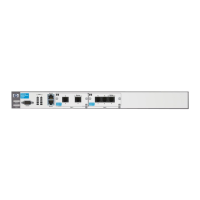13-15
Dynamic Host Configuration Protocol (DHCP)
Configuring a DHCP Server
Also, when you want to assign a particular host a permanent address, some-
times it is better to configure this address through a server, rather than through
whatever application is on the host. DHCP automatically tracks addresses so
that two devices are not inadvertently given the same address.
To assign a fixed address to a single host:
1. Create a new DHCP server pool with a name indicative of the host.
2. Identify the fixed-address host by its MAC address:
Syntax: hardware-address <MAC address>
For example:
ProCurve(config-dhcp)# hardware-address d2:17:04:91:11:50
3. Specify the IP address for the host. The router automatically assigns the
address with its natural mask. If your organization uses variable-length
subnetting, make sure to include the subnet mask or prefix length for the
host’s subnet:
Syntax: host <A.B.C.D> <subnet mask | /prefix length>
4. Specify the default gateway:
Syntax: default-router <A.B.C.D>
5. Configure other settings such as DNS and WINS servers and a domain
name. (See “Specifying DNS, WINS, and Other Servers” on page 13-11).
You can also assign the client a name:
Syntax: client-name <name>
For example:
ProCurve(config-dhcp)# client-name LAN2Switch
Configuring DHCP Scopes
The ProCurve Secure Router supports VLAN tagging so that it can receive
traffic from more than one VLAN on the same Ethernet interface. Therefore,
the ProCurve Secure Router might receive DHCP requests from clients on
different subnets on the same physical interface.
You can configure a separate DHCP scope to accommodate each VLAN.
Simply configure the DHCP pool with the VLAN’s network address just as you
would configure a typical DHCP pool.

